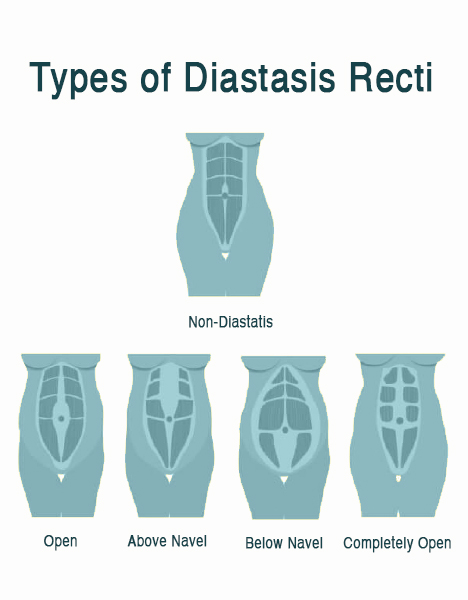Diastasis recti is a separation of the abdomins muscles that typically occurs in pregnant and postpartum women but can also be present in men. The rectus abdominis muscles (six-pack ab muscles) stretch during pregnancy. The separation can make a person’s belly stick out or bulge months or years postpartum
What is diastasis recti?
Diastasis recti (also called diastasis rectus abdominis, rectus abdominis diastasis, or diastasis) is a separation between the right and left rectus abdominis muscles. The condition most often arises in the second or third trimester of pregnancy.
However, the condition is not confined to pregnancy. Newborns and men can also be affected by the condition. It can occur as a result of wear and tear, obesity and genetic predisposition.
Along the front of your stomach, the rectus abdominis runs vertically. It is separated into left and right sides by a longitudinal band of connective tissue called the linea alba. The abdominal wall is stretched when the uterus swells and pushes on internal organs during pregnancy, and the linea alba thins and pulls apart. As this band of connective tissue is pushed outward, it becomes wider.
Once you have delivered your baby, the linea alba might mend and rejoin. It is extremely elastic and retract backs (like a rubber band). When tissue loses its flexibility as a result of stretching, the abdominal gap does not close as completely as it should. This is referred to as diastasis recti.
If you have diastasis, your stomach may protrude below or above the belly button, giving the appearance of being pregnant long after delivery.

Is Diastasis Recti a type of hernia?
A recti diastasis looks like but is not a hernia as there is no tear or defect in the abdominal muscles, merely a stretching. However, a coexisting hernia can also be present. A coexisting ventral hernia and a rectus diastasis is a complex and significant clinical problem, as well.
The Iskandar Center specializes in complex hernia repair with coexisting conditions. If you have a coexisting hernia, please reach out to us for a consultation.
You deserve
renowned expertise and
unparalleled compassion.
How common is Diastasis Recti Abdominis?
It’s common among pregnant and post-partum women. About two-thirds of pregnant women have it.
Having more than one child increases the likelihood of this condition, especially if the pregnancies are close together in time.
What are the associated Diastasis Recti symptoms?
The main symptom of diastasis recti is a vertical bulge that appears above the belly button when one does a crunch or gets up from lying or sitting down.
Other symptoms that may be less distinguishable, but can signal abdominal separation include:
- constipation
- lower back pain (lumbar)
- urinary incontinence fecal incontinence
- difficulty breathing
- discomfort in body movements
- a weakened core
These symptoms can lead to a negative body image and impaired quality of life.
How is Diastasis Recti diagnosed?
The main diagnostic tool is a good physical exam by an experienced surgeon looking also for associated hernias. A CT scan could be performed to confirm and grade the rectus muscle separation. Recently, ultrasound has been shown to provide accurate information regarding the separation’s extent without using radiation or incurring additional costs. Separation is measured in the abdomen at five locations above and below the belly button. A separation of more than 3 cm is considered abnormal. Additionally, imaging can reveal the presence of a genuine hole in the wall, commonly referred to as a hernia.
Does Diastasis Recti require surgery?
Most patients with diastasis recti have no pain and are treated with core strengthening exercises.
Surgery is warranted in patients who have diastasic recti with an associated hernia or those who desire it for cosmetic reasons or if there is a significant weakness in the function of the abdominal wall. A concomitant hernia repair with reattachment of the muscles can be done in a minimally invasive or open fashion depending on the case and the presence or absence of excess skin.
How is Diastasis Recti surgery done?
When physical therapy fails to diminish the aberrant expansion of the linea alba and symptoms are severe, surgery may be considered. Surgery is typically explored 6–12 months after delivery, as the diastasis may resolve naturally during this time frame. Open, laparoscopic, and robot-assisted surgery are all surgical possibilities. Regardless of surgical type, each includes a plication of the rectus fascia. Plication is the act or process of folding. Typically, the front/anterior rectus fascia is plicated during the open approach, whereas the rear/posterior rectus fascia is plicated during laparoscopic and robot-aided approaches.
Plication can be carried out with or without the addition of mesh reinforcement. When a hernia repair is also needed, surgical mesh is employed.
The procedure carries some similarities to a tummy tuck surgical method.
How successful is Diastasis Recti surgery?
The success rate for laparoscopic surgery is high, as most studies report a 0% recurrence rate 6 months after laparoscopic surgery. A laparoscopic technique is commonly used when diastasis and ventral hernia coexists but the method can also be used when only treating an abdominal rectus diastasis.
Is surgery more effective than physical therapy?
A study comparing surgery with physiotherapy concluded that improvements in the two surgical treatment groups were significantly greater compared with the improvements in the physiotherapy group. Surgery patients reported decreased pain and a better quality of life.
What exercise can help Diastasis Recti?
Side-lying exercises, deep chest breathing, and modifications to daily movements and posture can possibly improve non-severe diastasis recti.
A physical therapist experienced in abdominal wall separation can ensure you perform the proper exercises correctly to avoid further separation.
What exercise should I avoid with Diastasis Recti?
Exercises that are commonly prescribed by athletic trainers can lead to further separation of rectus abdominis muscles. These include commonly the recommended crunches, sit-ups, push-ups, press-ups, and front flanks.
Check with a physician before beginning any exercise program if you have any symptoms of abdominal muscle separation.
Can Diastasis Recti be prevented?
Doing the proper strengthening exercises before and during pregnancy can help. Rather than performing traditional abdominal exercises on your back, focus on pelvic mobility exercises such as pelvic tilts, pelvic circles, and bridges during pregnancy. When combined with proper breathing, these exercises help to strengthen the connection between the abdominal and pelvic floor muscles.
A physical therapist can ensure you perform the exercises correctly.
Don’t Guess. Get Checked.
If you think you have diastasis recti symptoms, it is highly advised for you to seek out a medical assessment by a qualified physician. If surgery is needed to repair your diastasis recti abdominis or if you suspect you have a basic or complex hernia in conjunction with the condition, Dr. Iskandar would be happy to provide a consultation. As a leading complex hernia surgeon and abdominal wall surgeon, he can offer you a sound medical opinion on the best treatment options.


